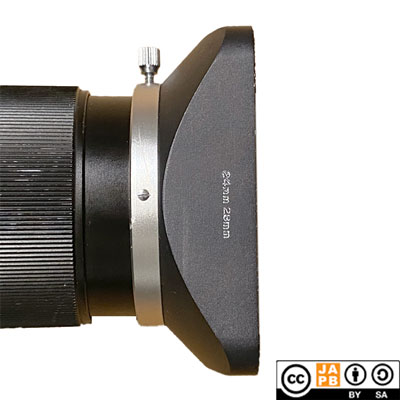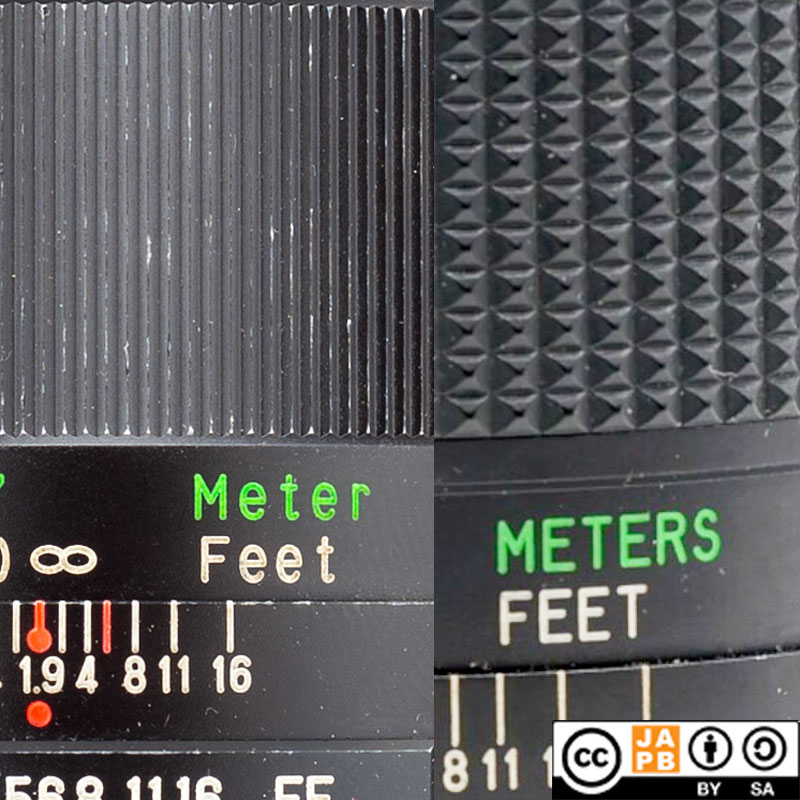Pekka Buttler, 11/2024

Specifications
The table below summarizes the lens’ key specifications (measurements based on pictured, last version of the lens):
| Brand: | Vivitar | Lens name | 35mm 1:1.9 auto wide-angle |
| Focal length(s)1 | 35 mm | Angle-of-view2 | 63° |
| Maximum Aperture | f/1.9 | In Production | unclear3 |
| Lens mount (this lens) | Konica AR | Other lens mounts | multiple4 |
| Length5 | 73,1 mm | Diameter6 | 63,8 mm |
| Filter ring diameter | 55 mm | Weight | 366 grams |
| Lens element count | 8 | Lens group count | 6 |
| Aperture blades (S/R/C)7 | 6 S | Focus throw | 270 ° |
| Minimum focusing distance | 30 cms | Maximum magnification | ≈1:6,4 |
| Has manual aperture ring | YES | Has Manual focus ring | YES |
| Aperture mechanism type: | Auto | Aperture click stops8: | 1.9•2.8•4•5.6•8•11•16 |
Further notes:
• This lens is a fast legacy 35 mm focal length SLR lens. There are altogether only a handful of legacy 35 mm focal length SLR lenses that have a maximum aperture larger than f/2.
• This lens was originally manufactured by Komine, seemingly exclusively for Vivitar because there are no other 35 mm f/1.9 rebrand lenses.
• This sample being intended for the Konica AR mount, it has the EE/AE setting on the focus ring (to allow shutter priority auto-exposure).
• While it is a relatively big lens, it is by no means exceptionally big considering its bright maximum aperture.
• It is unclear whether Vivitar originally included a lens hood in the package, but Vivitar did offer thread-mounted wide-angle lens hoods. Unless you want to go hunting for an original Vivitar lens hood, any wide-angle lens hood with a 55 mm filter thread should do the trick.
• Alternatively (as the lens front and filter threads do not rotate on focusing) you can use the clamp-on rectangular lens hood from the Konica Hexanon AR 28 mm f/3.5 lens as it is in plentiful supply and is in all respects a rather perfect match for this lens (and – in my opinion – looks kinda cool)

Versions and variations
There seems to be two distinct versions of the Komine/Vivitar 35 mm f/1.9 lens. The first (and based on classifieds) significantly more common version has a lengthwise ribbed metal focus ring and indicates its focus ring measurements as “Meter/Feet”. The sample pictured above is of this type.
The second and probably later version seems to be otherwise identical, but has replaced the metal focus ring with a rubberised (quadratic) pattern focus ring. Also the focus ring measurements are indicated as “METERS/FEET”
It is however unclear whether this was purely an ergonomic/cosmetic upgrade as nothing would indicate a change in optical design.
See picture below for illustration.

Right: Focus ring and distance markings on later version of lens
History of Vivitar
Vivitar initially was the trade name used by Ponder & Best Inc. until Ponder & Best changed its name to Vivitar Corp. From the 1960s to the early 2000s the company contracted various (mostly Japanese) optical and electronics manufacturers to manufacture photographic gear to be branded as Vivitar.
You can read more details in the Vivitar company profile.
Adapting
n.B! The following applies to all Konica AR mount lenses.
This lens cannot be used natively on any current SLR or dSLRs. To use it in its native environment, you will need a Konica AR-mount film body.
Thanks to being a fully manual lens (manual aperture, manual focus), the lens can be adapted to all mirrorless cameras using a suitable adapter. Moreover, Konica AR lenses are so uncomplicated that a simple ‘dumb adapter’ will do the job perfectly. However, due to Konica AR lenses not being among the most numerously manufactured, special adapters (helicoid adapters, tilt/shift adapters) are not easy to come by and speed boosters are currently unavailable.
Using Konica AR lenses on dSLRs is possible, but difficult. Due to the exceptionally short flange focal distance of the Konica AR mount (at 40,5 mm, a lot shorter than that of any full-frame dSLR mount), any adapter will necessitate some optics to achieve anything near infinity focus.
Footnotes
- Focal length is (unless stated otherwise) given in absolute terms, and not in Full-frame equivalent. For an understanding of whether the lens is wide/tele, see ‘Angle-of-view’. ↩︎
- Picture angle is given in degrees (based on manufacturers’ specs) and concerns the diagonal picture angle. Rule of thumb:
> 90 ° ==> Ultra-wide-angle
70–90 ° ==> Wide-angle
50–70 ° ==> Moderate wide-angle
40–50 ° ==> ‘Standard’ or ‘normal’ lens
20–40 ° ==> Short tele lens
10-20 ° ==> Tele lens
5-10 ° ==> Long tele lens
< 5 ° ==> Ultra-tele lens ↩︎ - Existing information is conflicting, likely introduced 1970. ↩︎
- Including: Canon FD, Contax/Yashica, Konica AR, M42, Minolta SR, Nikon F, Olympus OM and Pentax K ↩︎
- Length is given from the mount flange to the front of lens at infinity. ↩︎
- Diameter excludes protrusions such as rabbit ears or stop-down levers. ↩︎
- S=straight; R=rounded; C=(almost)circular at all apertures. ↩︎
- Numbers equal aperture values on aperture ring; • intermediate click; – no intermediate click. ↩︎